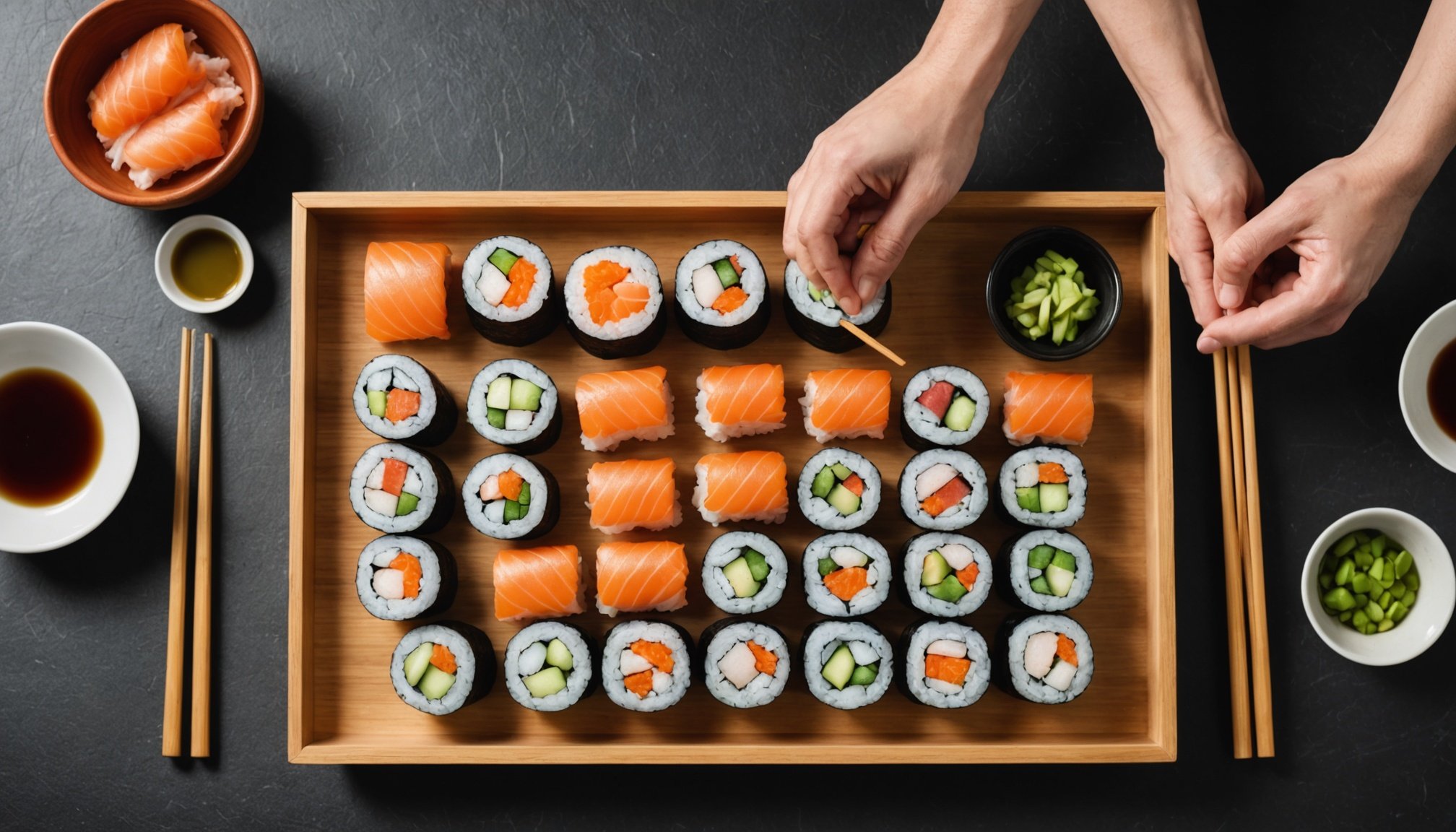Importance of Choosing the Right Sushi Rolling Kit
Selecting the ideal sushi rolling kit can significantly transform your sushi-making journey, especially if you’re just beginning. For novices, a quality sushi rolling kit offers a host of benefits. It simplifies the process and enhances your skill development, ensuring an enjoyable experience from the start.
The benefits of a quality sushi rolling kit are manifold. A good kit comprises the necessary tools like a reliable sushi rolling mat and a well-designed sushi knife, making the process smoother. These tools are specially crafted to assist in creating neat and tidy rolls, even for someone without prior experience.
Also to see : Maximize Your Kitchen Space: The Ultimate Guide to Choosing the Perfect Pasta Drying Rack
When considering sushi making for beginners, it’s essential to choose a kit tailored to your level of expertise. Beginner-focused kits often include comprehensive guides and additional utensils that aid in mastering basic techniques. Such features can boost confidence and instill enthusiasm in aspiring home sushi chefs.
The choice of sushi utensils plays a crucial role in the overall culinary experience. Choosing sushi utensils that are easy to handle not only enhances your comfort but also contributes to crafting the perfect roll. This attention to detail ensures you can savour both the process and the final product, making the journey to sushi mastery a rewarding endeavor.
Also to read : Discover the Most Durable Material for Your Drip Coffee Pot: A Guide to Longevity in Brewing
Types of Sushi Rolling Kits
Exploring the various types of sushi kits reveals a wide range of options suited for different expertise levels. Beginner sushi kits often include essential tools like a bamboo sushi rolling mat and a basic sushi knife, prioritizing ease of use. These kits may also feature helpful guides to aid novices in mastering initial techniques. In contrast, more advanced kits might provide additional, specialised tools aimed at perfected precision, catering to experienced sushi makers.
When browsing for sushi rolling equipment, it is important to consider the specific features to look for in beginner-friendly kits. Ergonomic handles on knives and non-slip mats can enhance safety and usability, making the experience enjoyable and efficient. Some kits support practice with templates that ensure consistent roll sizes.
A comparison between basic and advanced kits can help refine your choices. Basic kits offer simplicity and cost-effectiveness, while advanced kits boast premium materials and expanded toolsets. Selecting a kit that matches your intended frequency of use and learning ambitions will significantly impact your satisfaction and results. Understanding these differences ensures you choose the right equipment that aligns with your sushi-making journey.
Price Comparisons of Sushi Rolling Kits
When evaluating sushi rolling kit prices, it’s essential to understand the spectrum from budget to premium options. Budget sushi kits generally cost less and cater to beginners. They offer essential items needed for starting your sushi-making adventure without a hefty investment. Such kits typically include a basic sushi rolling mat and a simple cutting tool.
In contrast, premium sushi rolling products present a higher price point as they provide enhanced features and quality. These kits often include additional tools like a high-grade sushi knife and more durable mats. The investment in premium kits is reflected in their robust build and versatility, making them an excellent choice for serious enthusiasts or those who anticipate frequent use.
A crucial aspect of choosing the right kit is understanding the value offered by higher-end sushi rolling kits. These kits promise longevity and precision, attributes that can significantly improve the sushi-making experience. Despite the higher initial cost, the benefits of superior materials and comprehensive toolsets are worthwhile for dedicated sushi makers.
Ultimately, the decision boils down to your budget and culinary ambitions. Weighing these considerations ensures you select a kit that aligns with your needs and enriches your sushi-making journey.
Essential Features to Consider
When selecting a sushi rolling kit, prioritising certain features can greatly enhance your experience. A high-quality sushi rolling mat is crucial, as it provides a stable and flexible surface, enabling smooth roll formation. This feature becomes increasingly important for beginners who are still mastering fundamental techniques. Choosing a mat that is both sturdy and easy to clean will contribute positively to your overall sushi-making journey.
Next, a well-designed sushi knife is indispensable. It ensures precision and ease while cutting delicate sushi rolls. Look for knives with ergonomic handles for comfortable use, ensuring steady and safe handling. The sharpness of the blade is also a vital factor, as it affects the finish and neatness of the rolls. These considerations are central to achieving a professional appearance in homemade sushi.
A complete kit should also include other must-have tools, such as rice paddles and dividers, which facilitate efficient preparation. The inclusion of a detailed guide outlining basic techniques can be extremely advantageous for novices, offering insights and structured support. Opting for a kit with these key additions simplifies the sushi-making process and enhances user satisfaction. This thoughtful selection will undoubtedly elevate the quality of your sushi creations.
User Reviews and Testimonials
Understanding insights from sushi kit user feedback provides invaluable guidance, especially for beginners. User reviews often highlight how kits meet or fall short of expectations, focusing on aspects like ease of use and durability. Many novices praise kits that include comprehensive guides, citing these as crucial in their beginner sushi experiences. Kits that come with clear, step-by-step instructions are often preferred, as they foster confidence and ease the learning curve.
Common praises in customer reviews mention the quality and versatility of tools, particularly when kits include premium utensils. Users frequently commend kits with sturdy, easy-to-clean mats and sharp, ergonomic knives, noting how these enhance their sushi-making experience. Models that quickly wear out or display durability issues typically receive negative feedback, guiding others to seek more reliable alternatives.
Evaluating the reliability of user reviews necessitates discerning between personal preferences and consistent feedback patterns. High ratings for kits that balance cost and quality tend to point to genuine satisfaction. Another consideration is whether seasoned users report ease and enjoyment with the kit after frequent usage. Weighing these experiences can guide beginners in making an informed choice, selecting a kit that best aligns with their needs and preferences.
Tips for Successful Sushi Rolling
Mastering sushi rolling techniques is an art that becomes rewarding with practice and the right guidance. Begin by ensuring you have all necessary ingredients and tools within reach. Nori, sushi rice, and fillings are must-haves.
A crucial tip for beginner sushi tips is to avoid overfilling your sushi rolls. Overfilled rolls can become difficult to manage and might fall apart during the process. Measure the rice evenly across the nori, leaving a strip clear at the top for sealing.
Another essential element is understanding how to roll sushi effectively. Use your sushi rolling mat to gently yet firmly press and shape the roll. It’s important to keep uniform pressure to achieve that perfect cylinder shape. Adjust your grip slightly if the ingredients begin to slip.
Be aware of common mistakes to avoid for beginners, such as using wet hands while handling rice. Wet hands prevent rice from sticking to your fingers, but too much water can result in an overly sticky texture.
Following these best practices ensures that your rolls not only look appetising but are also a delight to taste. Practice provides the best learning experience, so embrace each attempt as a step closer to crafting the perfect sushi.
Frequently Asked Questions
In the universe of sushi making, beginners often have several sushi rolling FAQs. One common question is, “What is the best type of sushi rolling kit for novices?” For those new to sushi crafting, beginner sushi kits that include a bamboo mat, simple knife, and a detailed guide can be exceptionally beneficial. These kits generally facilitate easier learning and smoother practice.
Another query might be, “Why is a good sushi rolling mat important?” Simply put, a high-quality mat ensures a stable surface for rolling, crucial for maintaining the structure of the roll. The flexibility helps in achieving the necessary cylindrical shape without breakage, making it a fundamental aspect of the sushi kit information.
Aspiring sushi chefs often wonder about “the ideal utensils to start with.” Choosing the right sushi utensils can enhance the entire sushi-making journey. Look for ergonomic designs in knives and non-slip mats, which help maintain control and precision.
For those seeking further resources, websites and tutorial videos offer excellent beginner sushi queries resolutions, providing visual guidance and fostering a deeper understanding. Engaging with these supplementary materials can clarify doubts, enrich learning, and enhance skills, propelling one closer to sushi mastery.
Brief Introduction to Sushi Making
Embarking on your sushi making journey begins with understanding foundational elements. For beginners, recognizing essential sushi ingredients is pivotal. Traditional sushi typically includes sushi rice, nori (seaweed), fish, and a range of fillings like vegetables, cucumbers, or avocado. An awareness of these components sets a strong foundation.
When it comes to the sushi preparation process, starting with perfectly cooked sushi rice is crucial. This rice, seasoned with vinegar, sugar, and salt, is the base of most sushi types. Achieving the correct rice texture is half the battle won, ensuring that your rolls hold together beautifully.
Next, identifying different types of sushi leads to a more refined rolling experience. Maki, nigiri, and sashimi – each type has its craft and appeal. Understanding distinctions helps in grasping techniques and presentation styles, enriching your skills over time.
Sushi making basics not only involve technical knowledge but also appreciating the cultural heritage and tradition behind this culinary art. Initiating this exploration with the right tools, ingredients, and enthusiasm is a step towards a rewarding sushi-making experience. Engage with tutorials or culinary books for more in-depth guidance on these fundamentals as you progress in your craft.





